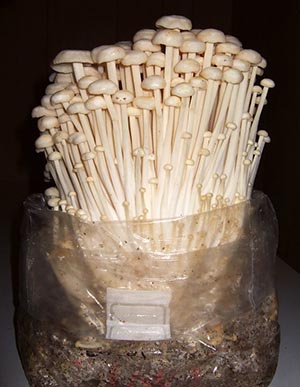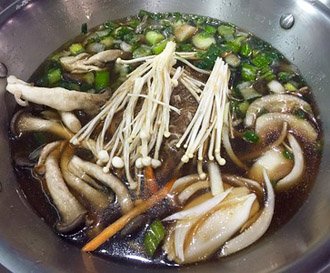Enoki mushroom (enokitake) Nutrition facts
Enoki mushrooms also called enokitake (エノキタケ), are slender and exceedingly delicate mushrooms with long thin stems and tiny white caps. In Chinese, they are called Jinzhen-gu (golden needle mushrooms) since they resemble the dried tiger lily buds. Fresh as well as dried enokitake are popular mushrooms in China, Vietnam, Korea, and Japan.
Genus: Flammulina.
Family: Physalacriaceae.
Scientific name: Flammulina velutipes.
 |
| Enoki mushrooms. Courtesy: Wendell Smith. |
Identification
Enokitake features an elongated fruiting body, comprising of a long thin stalk and small, biconvex cap. Completely grown enoki measures 10-15 cm in length and 1-3 cm diameter small caps. In Japan, it is cultivated in different-sized bottles according to the market preferences. Enoki has a mild fruity flavor and chewy texture.
Cultivation
Enokitake is a winter fungus that prefers milder average temperatures to produce thin, elongated stems and small caps. In the natural, wild enoki appears on the persimmon, Chinese hackberry, and sometimes pine forests. Wild enokitake tends to be pigmented and features short stems and broad, brown caps.
Cultivated enoki requires dark, cold, high carbon-dioxide surroundings for ideal growth. Farmers usually grow in bottles, on spawn inoculated degradable lignocellulosic bio-residues such as corn cobs, and wood straw as nutrients for their growth and fructification. Many cultivated varieties with white stems and caps are developed keeping in mind consumer preferences.
Health benefits of Enoki mushrooms
Enoki mushroom is a very low-calorie fungus. 100 grams of fresh enoki carry about 37 calories.
Laboratory studies on animals suggest that proflamin, a compound in F. velutipes has been found to have anti-tumor activity against cancers such as adenocarcinoma, melanoma, etc. in animal studies.
Enoki mushroom is another fungal candidate with an ideal source of B-complex vitamins. It contains pantothenic acid-27%, niacin-44%, folates-12%, thiamin-19%, and riboflavin-15% of daily required values. Many of these vitamins are involved in protein, fat, and carbohydrate metabolism inside the cells, as co-factors for substrate enzymes.
Enokitake contains more niacin than many other edible mushrooms. 100 gras of enoki carries 7.032 mg of niacin. Niacin helps in the prevention of pellagra disease.
Just like shiitake mushroom, enokitake too carries a good amount (105 mg or 15% DV) of Phosphorus. Adequate calcium and phosphorus levels in the blood are critical for the proper mineralization of bone and teeth.
Enoki is a very good source of potassium, an anti-sodium electrolyte. 100 grams of fresh enoki carries 359 mg or 7.5 % of potassium.
Enoki does not have much vitamin D (ergocalciferol, 4 IU/100 g), unlike other large-sized mushrooms like bolete.
Further, it is a good source of minerals such as phosphorus-15%, copper-12%, zinc-6%, and iron-14% of daily values.
| Principle | Nutrient Value | Percent of RDA |
|---|---|---|
| Energy | 37 Kcal | 2% |
| Carbohydrates | 7.81 g | 6% |
| Protein | 2.66 g | 4.75% |
| Total Fat | 0.29 g | 1.5% |
| Dietary Fiber | 2.7 g | 7% |
| Vitamins | ||
| Folates | 48 μg | 12% |
| Niacin | 7.032 mg | 44% |
| Pantothenic acid | 1.350 mg | 27% |
| Pyridoxine (B-6) | 0.100 mg | 8% |
| Riboflavin | 0.200 mg | 15% |
| Thiamin | 0.225 mg | 19% |
| Vitamin-D | 4 IU mg | 1% |
| Electrolytes | ||
| Sodium | 3 mg | <1% |
| Potassium | 359 mg | 7.5% |
| Minerals | ||
| Calcium | 0 mg | <1% |
| Copper | 0.107 mg | 12% |
| Iron | 1.15 mg | 14% |
| Magnesium | 16 mg | 4% |
| Manganese | 0.075 mg | 3% |
| Phosphorus | 105 mg | 15% |
| Selenium | 2.2 μg | 4% |
| Zinc | 0.65 mg | 6% |
Selection and storage
Enoki is best available from October till May; hence, the name winter mushroom. In the stores, one can easily identify them by their strikingly long stems and tiny caps, usually wrapped in cling films, from a distance in the vegetable/mushroom sections. Choose white, firm, and shiny enoki mushrooms. They are sold in bunches in plastic containers/wraps, especially in Asian grocery stores.
Avoid any that have damp, slimy patches and those that have discoloration. They are also sold in jars or cans but prefer fresh over canned.
If you buy fresh enoki mushrooms, they will keep for one week in their packaging when placed in the salad compartment of a refrigerator.
Preparation and serving methods
Enoki is one of the delicate gourmet mushrooms. Fresh mushrooms rarely require washing. The mushrooms are harvested in clumps, attached to a tough, spongy root base which is cut off. So, trim the 1-1.5 inch lower clump base before using it in the recipes. You can use these trim ends to make stock.
Soak dry enoki mushroom in warm water for 10 minutes to rehydrate. Do not discard the soaking liquid as it can add flavor to stock, or use it in soups, sauces, stews, and stir-fries.
Do not overcook, add at the end of cooking time. Enoki mushrooms have a delicately sweet and almost fruity flavor and a delicate soft texture.
 |
| Shabu shabu-hot pot with different kinds of mushrooms and vegetables is a Japanian recipe. Anokarina |
Here are some serving tips:
-
Enoki mushrooms are delicious raw. They decorate and flavor salads, vegetables, and stir-fried dishes.
Nametake is a popular rice dish served with sauteed enoki with seasonings of soy sauce, mirin, and herbs.
They can be added to soups, sauces, pasta dishes, stews, and omelets.
Safety profile
Allergic reactions to enoki mushrooms are rare. Some sensitized persons who actively take part in the cultivation may develop allergic contact dermatitis to this mushroom.(Medical disclaimer).
You may also like to read:-
Bolete mushroom nutrition facts and health benefits.
Button mushrooms nutrition facts and health benefits.
Morel mushrooms nutrition facts and health benefits.
Truffles nutrition facts and health benefits.
≻≻-Back to Mushrooms from Enoki mushroom nutrition. Visit here for an impressive list of edible mushrooms with complete illustrations of their nutrition facts and health benefits.
≻≻-Back to Home page.
Further reading and Resources: